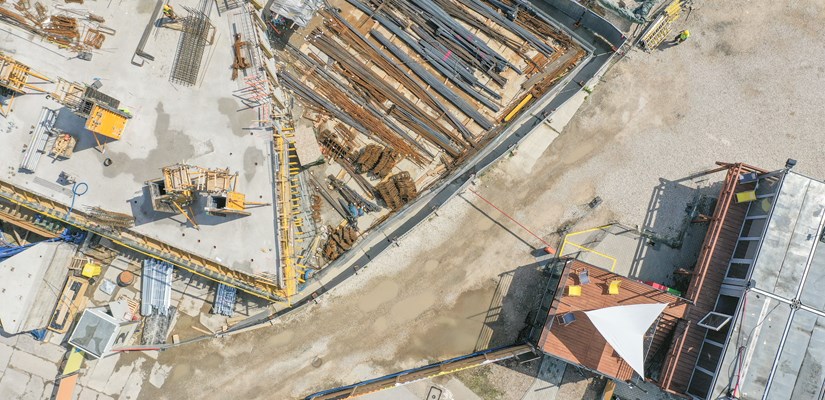Skanska’s commercial development business unit in CEE is persistently striving to reduce carbon dioxide emissions by 50% by 2030. The company also declares that it will achieve emission neutrality by 2045. The developer, together with the manufacturer and supplier of building materials – CEMEX – is now introducing another innovation to the Polish market, which will bring us closer to achieving this goal. It is low-emission concrete Vertua®, which was used on a large scale for the first time on the developer's Warsaw project - in the P180 office building in Warsaw.

The systematic expansion of urban agglomerations and the emergence of new investments contributes to the emission of greenhouse gases. At the same time, the European Union, as part of the New Green Deal, will impose more and more obligations on the member states related to the reduction of CO2 emissions. This is meant to reduce global warming and respond to the need to build cities using low-carbon technologies. The percentage of concrete in the so-called built-in carbon footprint of Skanska buildings, is approximately 56% of all the following material groups - steel, aluminium, glass, ceramics.
Skanska, as the first developer in Central Europe, decided to use a concrete with a reduced carbon footprint called Vertua® plus, the emissivity of which is on average 42% lower than that of traditional concrete mix. The ground-breaking product was launched by CEMEX, a global supplier and manufacturer of building materials.
The concrete was laid as part of the construction of P180 - Skanska's office investment. The building is under construction in Warsaw next to the Wilanowska metro station. As part of the project, almost 3,500 m3 of low-emission concrete has been used so far, thanks to which the level of carbon dioxide needed to produce this concrete has been reduced by an average of 42% than if the investment had used traditional concrete made of the most popular cement CEM I 42,5R. The amount of CO2 reduced this way corresponds to a passenger car (fueled with gasoline) orbiting the Earth along the equator 42 times (calculation according to BEIS, 2019, Greenhouse gas reporting: conversion factors 2019).
Concrete with reduced CO2 emissions - how does it work?
Reducing the carbon footprint (lower CO2 emissions during production) of concrete is a complex process that involves many factors, such as: properly designed mix recipe, use of low-carbon cement and local raw materials, as well as use of alternative fuels (at the production stage) and mineral additives for cement.
– At Skanska, we are actively working to reduce our carbon footprint as part of our ambitious climate goals, starting with activities that have the greatest impact on the environment. Therefore, for the sake of the environment, we focus not only on the use of buildings, but also on the way they are built and the process of selecting appropriate materials. One of the innovations that we use in the production of necessary materials is low-emission concrete, says Adam Targowski, Director of Sustainable Development at Skanska Office Unit, and adds – We are constantly looking for new forms of cooperation with various companies in connection with the implementation of our sustainable projects. For example, one of our initiatives is working with Signify to use innovative lighting in office buildings that reduces energy consumption. After using green concrete and anti-smog pavements in several of our projects in Poland, the time has come for low-emission concrete, which we would like to ultimately use in all our projects in Central and Eastern Europe.
Sustainable development in Skanska’s DNA
Skanska has been guided by a "green" approach in business for many years. One of its direct effects are buildings that are 100% powered by renewable energy sources, such as Centrum Południe in Wrocław or the Wave office building in Gdańsk. As part of a strategy based on climate goals, Skanska is working on various innovative and pro-environmental solutions. For example, thanks to the cooperation with Saule Technologies established in 2018, testing of photovoltaic perovskite cells was started. Cells made of them are already as efficient as silicon cells. They are flexible, very thin, light and translucent. They maintain high efficiency in energy production, even if the sun's rays do not fall on them at an optimal angle. This means that their use is not limited to the roof only - they work effectively on any surface. The solution was tested in the Spark office building in Warsaw, and then a pilot production line was launched, enabling the production of cells in a larger format.
– For us, the "green revolution" is not just a trendy slogan, but real and systematically implemented solutions. For many years, it has been an important part of Skanska's business - the way we design and build. It is also directly related to the values of our company. We are actively looking for new partners offering construction solutions that reduce negative impact on the environment. Our collaboration with Cemex and the use of low-emission concrete during the construction of P180 is a good example of this, sums up Adam Targowski.